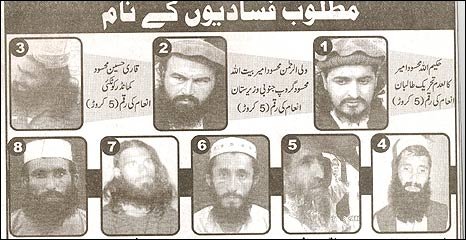 |
|
Eight South Waziristan Taliban commanders, pictured in a ‘wanted’ poster that was released by the Pakistani government in 2009. Mufti Noor Wali Mehsud is #6, pictured in the middle of the bottom row. The other commanders pictured are: 1. Hakeemullah Mehsud, 2. Waliur Rehman Mehsud, 3. Qari Hussain Mehsud, 4. Azam Tariq, 5. Maulvi Azmatullah, 7. Asmatullah Shaheen Bhittani, 8. Mohammad Anwar Gandapur. |
The United Nations Security Council (UNSC) added Movement of the Taliban in Pakistan emir Mufti Noor Wali Mehsud (Wali) to its list of terrorist leaders and operatives who associated with Al Qaeda. While Wali’s Movement of the Taliban in Pakistan (Tehrik-e Taliban Pakistan, or TTP) has carried out few major attacks inside Pakistan, it has stepped up small scale operations against Pakistani security forces in North and South Waziristan over the past several months.
The UNSC added Wali to the Al Qaeda Sanctions List on July 16, 2020 for “participating in the financing, planning, facilitating, or perpetrating of acts or activities by, in conjunction with, under the name of, on behalf of, or in support of” Al Qaeda.
The TTP has been a close ally with Al Qaeda since its formation in 2007. Files seized from Osama bin Laden’s compound detail the close relationship between the two; one file even details how Al Qaeda leaders dictated the writing of the TTP’s charter. In a recent video that lauded its second emir, Hakeemullah Mehsud, the TTP celebrated its close ties and coordination with the Afghan Taliban and its sub-group the Haqqani Network, as well as central Asian jihadist groups such as the Islamic Movement of Uzbekistan, and “Arabs,” a not so subtle nod to Al Qaeda.
Wali was named the emir of the TTP on June 23, 2018, the same day it announced the death of Mullah Fazlullah, its previous leader. Fazlullah, like his predecessors Hakeemullah Mehsud and Baitullah Mehsud, were killed in U.S. drone strikes. Fazlullah was killed in Afghanistan, while Hakeemullah and Baitullah were both killed in Pakistan.
The TTP is responsible for a deadly insurgency inside Pakistan that began in 2007 and saw much of the Federally Administered Tribal Agencies and a number of districts in Khyber Pakhtunkhwa province fall under its sway. The Pakistan military ceded ground in the tribal areas to the TTP time and time again under the guise of so-called “peace deals.”
The TTP became emboldened, broke the deals, launched deadly suicide attacks throughout the country, and forcibly took control of more territory until it was only 60 miles from Islamabad. Only then, in 2009, did the Pakistani military begin to fight back. By 2014, much of the TTP’s gains were rolled back until it went underground and suffered defections after naming Fazlullah its emir.
By early 2017, most of the breakaway TTP factions returned to the fold, with Al Qaeda and the Haqqani Network mediating between the factions. While the TTP’s insurgency was largely moribund, it has survived due to support from both the Afghan Taliban as well as non-TTP Pakistani Taliban factions that are backed by the Pakistani state.
The TTP has also sought refuge with the Taliban inside Afghanistan. A recent United Nations assessment estimated that between 6,000 and 6,500 Pakistanis, many whom belong to the TTP, are waging jihad in Afghanistan.
While the TTP’s fortunes in Pakistan have been bleak over the previous several years, there are indications that it may be reigniting its insurgency. Over the past year, the TTP began to assert itself in its traditional stronghold of South Waziristan. In April 2019, a senior leader of the Awami National Party (ANP), which has been ruthlessly attacked by the TTP over the years, said that “peace committees” are responsible for security in the district, Dawn reported. These same so-called peace committees facilitated the Taliban takeover of the tribal areas in mid-2000s.
The ANP leader also said that the Taliban are “delivering speeches and collecting donations in mosques” as security in the region deteriorated.
In June 2020, the Awami National Party accused “local tribal leaders in South Waziristan” of “handing over responsibility to maintain peace” to the Taliban, Dawn reported.
While security has deteriorated in South Waziristan, the fighting between the TTP and the Pakistani military has intensified in North Waziristan. Since the beginning of March, 13 Pakistan soldiers were killed during fighting in and around the Taliban bastions of Datta Khel and Miramshah, according to the Pakistan military’s Inter-Services Public Affairs branch.
The U.S.-Taliban deal, which calls for the withdrawal of all American troops by April 2021, may also fuel the resurgence of the TTP. At the moment, the TTP has focused much of its energy fighting alongside the Afghan Taliban, while the U.S. has created problems for TTP by killing its emirs and leaders in airstrikes and raids. With the U.S. gone and the likely Taliban takeover of large areas of Afghanistan, the TTP can then redouble its efforts to regain control of areas in Pakistan’s northwest.
Are you a dedicated reader of FDD's Long War Journal? Has our research benefitted you or your team over the years? Support our independent reporting and analysis today by considering a one-time or monthly donation. Thanks for reading! You can make a tax-deductible donation here.
from Long War Journal – FDD's Long War Journal https://ift.tt/3jfEDZy
via Defense News
No comments: